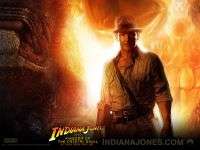Is Indy chasing a fake?

As Indiana Jones races against time to find an ancient crystal skull in his new movie adventure, he should perhaps take a moment to check its authenticity.
New research suggests that two well-known crystal skulls, in the British Museum and the Smithsonian Institution, Washington DC, did not, after all, come from ancient Mexico. Academics now believe the British skull was made in 19th century Europe and the American one even more recently.
The British Museum bought its skull, a life-size carving from a single block of rock crystal from Tiffany and Company, New York in 1897. Its origins were unknown but there were suggestions it was of ancient Mexican origin. Human skulls worn as ornaments and displayed on racks were known to have featured in Aztec art.
The skull attracted a lot of public attention and speculation it was once thought to have healing powers. Crystal skulls have since featured in many books, articles and films, most recently in the new Steven Spielberg movie Indiana Jones and the Kingdom of the Crystal Skull.
However, there have been doubts about the authenticity of the skull since the 1930s. Now an international team has used the latest scientific techniques to examine the British Museum skull and a larger white quartz skull donated to the Smithsonian Institution in 1992.
Electron microscope analysis for tool marks found both skulls were carved with rotary disc-shaped tool – a technology which the Ancient Mexicans did not have. Analysis of the quartz in the British Museum skull suggests it was quarried from Brazil or Madagascar – far outside the Ancient Mexicans’ trading links.
The team, made up of experts from Cardiff University, the British Museum, the Smithsonian and Kingston University, concluded that neither skull could have been made in Mexico before the time of Columbus. They believe the British skull was created in Europe in the 19th century, and the Smithsonian’s shortly before it was bought in Mexico City in 1960.
Professor Ian Freestone, of Cardiff University’s School of History and Archaeology, said: “It is always disappointing when an intriguing artefact like a crystal skull turns out not to be genuine. However, it is important to be precise about what is authentic and what is fake if we are properly to understand our past. Maybe Indiana Jones will have better luck in his hunt for a real crystal skull!”
Source: Cardiff University





















